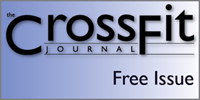CrossFit is an excellent fitness program and its adherents see marked improvements across all aspects of fitness. It's effects can be seen as the months pass and repetition numbers (think pull-ups, push-ups) and one rep maxxes (think deadlift / squat) go up while runs and named WOD times go down. This sport of fitness provides plenty, and people are thrilled with the results. With that said, why set specific fitness goals? Isn't CrossFit a GPP (general purpose preparedness) program that is supposed to increase fitness across multiple domains? And with its constant variety, how can you focus on specifics?
Anyone who has worked out for a long time will tell you that eventually the body will hit a plateau. These plateaus are where fitness progress stalls in an area and getting past them is difficult. Because CrossFit is constantly varied, when a plateaus is reached it can be less obvious than with traditional linear strength or cardio based programs. The only way out of these plateaus is to focus on them specifically, setting short term goals that help to keep these plateaus at bay. Using short term fitness goals and charting your progress will also help keep you more interested in working out. These goals need to be measurable, something you work towards instead of just the amorphous "being in shape."
There are several methods to set short term fitness goals. Looking at CrossFit Seattle, they have created an excellent skill level chart. The CFT chart is another. One or more aspects of any of these standards can be used as a fitness goal, then tweaking your current program to add extra focus towards attaining those goals.
To illustrate how this can be done, I'll use my past goal of a 1,000 lbs CrossFit Total (CFT) as an example. First off, my CFT had hit a plateau and was hovering in the low 900's for almost a year. Having identified a specific goal (reaching 1,000 lbs), I needed to address what was holding me back and how to go about fixing it. I figured I would get the most bang for my workout buck by focusing on bringing up my squat and deadlift weights. To do this I went to an ME blackbox method, replacing the second workout of every three with a specific strength day focusing on these strength areas. I rotated the heavy lifting exercises ever second workout. When the CFT came around in October, I set a PR in all three events and hit a total of 1,005 lbs. Without specifically focusing the way I did, it might have been months if not years before I would have seen the same results.
Once a goal has been met there is a real feeling of accomplishment. That goal complete, you can shift your focus to the next thing over the horizon to conquer. It can be along the same lines, or totally shifting to a completely different aspect of fitness. This approach helps keep workouts interesting, showing measurable forward progress and keeps overall fitness levels increasing. Just like wanting a 1,000 lbs CFT, any aspect of fitness can be used as a goal as long as its measurable. Some examples:
A faster 5k run time
A specific number of pull-ups
Increased weight of a one repetition maximum lift
A specific score or time for a named or repeating WOD
Success in a skill (performing a muscle-up, holding a handstand, etc)
There are countless ways to adjust your workouts to accommodate working toward specific goals. You can replace a WOD like I did with tailored exercises or add volume to your program. Adding another full workout during the day or accessory work before or after your normal WODs will accomplish this. For my handstand, I tried to practice for 5-10 minutes after every WOD. Consistency is the key, especially for skill-based goals.
So what are you waiting for? Set a specific fitness goal and start working towards it!
Sunday, November 25, 2007
Subscribe to:
Post Comments (Atom)


1 comment:
well said Rick
Post a Comment